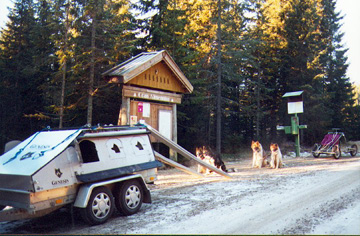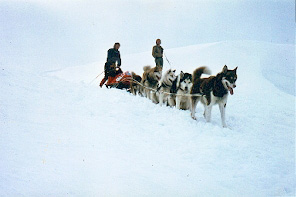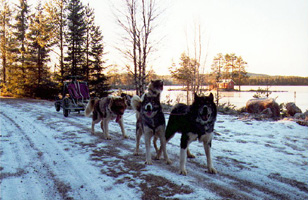Table of Contents
*
Featured Inuit Dog Owner: Ove Nygaard
*
An Amazing Lead Dog: The Story of Tatra
*
A Mystic Reunion
*
Katan, the Greenland Pup
*
Oregon Dune Musher's Mail Run
*
High Arctic Mushing: Part II
*
Bibliography: Inuit Sled Dog Research
*
Video Review: Atanarjuat, The Fast Runner
*
Book Review: To a Lonely Land I Know
*
IMHO: Visibility
Navigating This
Site
Index of articles by subject
Index
of back issues by volume number
Search The
Fan Hitch
Articles
to download and print
Ordering
Ken MacRury's Thesis
Our
comprehensive list of resources
Talk
to The Fan
Hitch
The Fan Hitch
home page
ISDI
home page
Editor: Sue Hamilton
Webmaster: Mark Hamilton
Contents of The Fan Hitch Website and its publications are protected by international copyright laws. No photo, drawing or text may be reproduced in any form without written consent. Webmasters please note: written consent is necessary before linking this site to yours! Please forward requests to Sue Hamilton, 55 Town Line Rd., Harwinton, Connecticut 06791, USA or mail@thefanhitch.org

There are hundreds of miles of trails with small road crossings here, good for
training left and right. There are also many small rivers for watering dogs. In
winter these roads are not plowed - a nice place for mushers. Nygaard photo
Featured Inuit Dog Owner:
Ove Nygaard - Roa, Norway
F.H. How long have you been involved with sled
dogs?
O.N. Approximately 30 years.
F.H. Did you start out with ISDs? If not, how
long have you
owned ISDs?
O.N. I've had dogs all of my life, and was born in
a home with
hunting dogs (Harehounds and Elkhounds), but the last 30
years it's been
Greenland Dogs.
F.H. What attracted you to ISDs?
O.N. Their rough way of handling cold weather, and
their ability
to work in all conditions whatever the weather is like,
and to give me
the right companionship outdoors all the time.
F.H. Where did you get your ISDs?
O.N. A local owner/breeder.
F.H. How many dogs do you have?
O.N. I've got four dogs now, two males and two
females.
F.H. What kind of activities do you do with your
ISDs?
O.N. First of all sledding in the winter and
carting through
the spring/summer/autumn for regular conditioning and
touring, counting
more hours and days we've been out than seconds and how
many kilometers
we've got behind us. If the dogs work well, that's what I
look for. I also
bring my dogs along when I'm tenting and fishing and for
walks in the mountains
and in the forest.
F.H. What kind of harnesses, carting/sledding
equipment do you use?
O.N. I use a cross-back harness from Bernd Weshle
in Germany.
I also use an Opsal Treindustrier sled (manufactured by
Thorleif Nordengen
in Norway), but I've ordered a new one from BeWe (Alpi 2),
and I use a
cart from Fritz Dyck (the TOM-model) for training during
the summer and
autumn. You can see these sleds and carts at
<www.bewe-sleds.de>
F.H. How do you kennel your dogs?
O.N. I've got one big yard with 2.5 meter high
fence around
it. Each dog is picketed on a five meter chain next to a
house (warm and
dry) but they can all reach each other to touch
noses. Every day
they're all allowed to run free two or three times and how
long depends
of how much time we've been sledding/carting.
F.H. What do you feed your dogs?
O.N. I feed them approximately 60% raw meat (from
www.provit.no)
and 40% dry food (Genesis Performance from Gary Harrison
at www.harrisonpet.com
in Canada). I add minerals and vitamins, and during the
winter I also add
salmon oil for more energy into the feeding program.
F.H. Do you breed ISDs?
O.N. Hmmm,...... yes I think I might say yes to
that, but not
regularly; one or two litters a year, but only when I need
new dogs for
myself and a friend. My last litter was in 1999, and may
be I'll have one
this year - or the next.

Ove and his team, Tatra in lead, atop a
mountain on the
last downhill
section of a race. Ahead a team of two
men and six Siberian
Huskies
lost contol, rolled over and over,
ending in a big snow
pile, ears and
legs sticking out here and there.
As Ove went by,
the drivers yelled,
"When you reach the finish
line, tell
them we'll go directly home
from
here."
Nygaard
photo
F.H. What is your interpretation of an Inuit Sled Dog?
O.N. Their honesty; they require nothing but
food and
water; a close connection to the owner/musher when taken
good care of,
and the way they seem to go with the nature all the time.
By that I mean
their ability to deal with all the conditions we meet when
we're sledding,
such as cold weather, wind, deep or blowing snow, poor
visibility, finding
their way, etc. etc.
F.H. Where did the original ISDs in Norway come
from? Are any
dogs brought into the Norwegian gene pool from Greenland
or Canada?
O.N. They came from Greenland and Canada. Many of
the early
expeditions in the Arctic areas - as well as in the
Antarctic - brought
dogs back to Norway. We got several dogs from the Sir
Vivian Fuchs Antarctic
expedition of 1957/58. Also, many dogs were imported
by private persons
who had interest in the breed. From 1947 to 1963 an
organization
for mushers, the Norsk Trekkhunklubb, imported thirty-six
Inuit Dogs from
Greenland and areas around, and in 1959 twelve dogs were
imported from
Hudson Bay in Canada where they had been used in an
English-made movie.
Recently some dogs have been brought to Norway from
Greenland. However
these are small, thin and looking more like a
mix-breed-husky. They
have hip problems as well.
F.H. In terms of phenotype, health, temperament and
performance,
what is your view of the ISD in Norway, from long ago up
until today?
O.N. There have been no big problems with their
health. Inbreeding
has resulted in some problems with the hips in some
lines/kennels, and
there have also been a few dogs who have had hypothyroid
problems. Temperament
has been good. This has been "The most healthy breed" in
Norway - so far.
However, inbreeding as well as cross breeding, AND
SPECIALLY THOSE THINGS
TOGETHER IN THE SAME PROGRAM, have been a disaster for the
breed. We're
getting all kind of problems today, and it's no doubt that
we also
got the Merle-gene into the breed on those lines. That's
why I'm staying
away from those breeders and their dogs/lines for my own
breeding program.
Breeds such as Border Collie, Welsh Corgi, Dalmation,
Dunker (harehound)
carry the Merle-gene, and that can bring irregular spots
to the coat and
also blue eyes. We don't know what causes blue eyes in the
Siberian Husky,
but there might be a connection, or the Merle-gene may
have been brought
into the breed in other ways. But I believe that blue-eyed
Greenland Dogs
are happening because of mix breeding with other sled
dogs. Merle-gene
can have effect on both coat and eyes. If you do have a
dog with a sable
coat-color, the Merle-gene is not phenotypically expressed
in that color
although the dog may carry the gene as - Mm. But if you
breed that dog
with another Mm dog, you'll get almost white pups.
The same is with
spotted coats (mostly small spots) - dark against a
lighter background,
and the Mm dogs can also have blue or blue spotted eyes.
Dogs with Mm or
mm do not have more sickness than other dogs, but if we
come to MM it's
different. Those dogs become all white, often blind and
deaf, and they're
sterile. It's advised not to breed two dogs with
merle-gene, but if that's
what is the reason of the blue eyes in Norway, I can tell
you that they
officially inbreed with this defect.

Ove's dogs on a 30 km's tour in November
in the forest
60 km
north of Oslo,
Norway
Nygaard
photo
F.H. What do you think is the future of the ISD in
Norway?
O.N. The future of the purebred ISD in Norway is
not good. I'm
afraid of the results other breeders are getting with
their dogs who are
not pure, coming up with different kinds of defects and
less healthy dogs.
In the rest of the world? Europe has got some of the same
problems, and
that is very much because of one breeder in Norway who has
been selling
dogs from that breeder's own lines/kennel all over with no
honesty for
the breed, but for only one purpose - earning money.
Besides that, we can
see that the smaller and faster dogs are becoming more
common and "accepted"
and as their numbers grow, the average person and the
owners of these dogs
believe that they should be looking that way. The official
breed clubs,
as well as the Kennel Clubs, are making no effort
whatsoever to keep
the breed as in origin, instead allowing breeders to
transform the
ISD into something else. Even worse, because some,
including me, have been
so outspoken and have asked the NKC and the Danish Kennel
Club (DKC) to
take a stand against these unhealthy breed changes, the
Norsk Polarhundklubb
(NP) has removed these people from their official
positions with the breeding
program, appointing in their place breeders who accept
breedstock with
blue eyes as "normal" and who find it not unusual to see
even in the pure
dogs in Greenland! The NKC and the DKC challenge
neither the changes
in the breed nor the removal of those who oppose these
changes from their
official capacity. NP has rebuked them for bringing these
issues out into
the open instead of recognizing their right to oppose
these changes because
they - as I do - want to keep the breed pure and in its
original form.
Not only do these clubs not want to read the message, they
have made the
conscious decision to kill the messengers. And so our best
way to keep
the Inuit Sled Dog for the future is with a strong
organization- Inuit
Sled Dog International.
F.H. What would you like to say to ISD
breeders/owners elsewhere
in the world?
O.N. Be true to the breed and its history. A dog
already perfected
for its purpose over centuries of arctic conditions, there
is no need for
us to try to “reinvent” the breed. We must preserve its
heritage for the
future - the ISD's original way of living and
nature. Be honest when
it comes to selling puppies. Tell those who want to buy
one, "If you need
or want a fast, light dog who that might be used for
racing, go buy an
Alaskan Husky if you like to win, or a Siberian Husky if
you like to come
in as number three. These are the breeds for you if the
weather conditions
are still changing to warmer for the future. But if you
need a dog who
is always beside you in the worst of weather conditions
and will be sure
to reach the point on the map you've been aiming at, and
the times you
spend outdoor together with the dogs is more important
than getting back
to the house for a cup of tea in the shortest possible
time, then
there is only one breed in the world -THE INUIT SLED DOG,
by whichever
name you call them, Canadian or Greenland Inuit
Dog." If they don't
listen to this, don't sell any puppy to them!